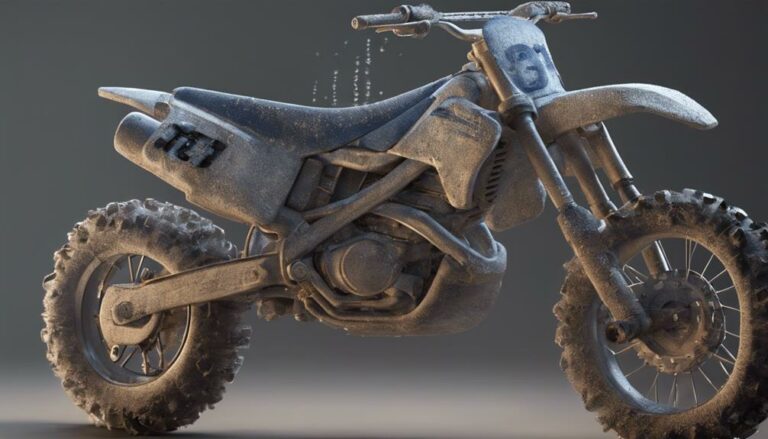Check coolant level against marks in header tank. Look for leaks by inspecting components and radiator. Safeguard radiator with mesh. Clean radiator regularly to prevent blockage. Utilize radiator cover for extra protection. Sustain airflow for efficient cooling. Keep a watch on coolant level and rad cap. Prevent overheating by cleaning radiator fins. Guarantee longevity and performance.
Key Takeaways
- Check coolant level in header tank against indicators on level ground.
- Inspect for leaks on components, radiator, and overflow tank.
- Maintain radiator with regular cleaning, flushing, and inspection.
- Use radiator protection, monitor coolant level, and prevent blockages.
- Consider adding a radiator cover for extra protection against debris and impacts.
Coolant Level Check
To begin checking the dirt bike's cooling system, start by locating the coolant header tank and examining the level against the marked indicators while making sure the bike is on level ground. The coolant level should ideally be between the high and low marks on the tank. If the level is close to or below the low mark, it's important to add coolant.
Refill the coolant through the designated cap on the header tank following the manufacturer's recommendations to maintain the correct level. Regularly monitoring and maintaining the coolant level is vital for the proper functioning of the cooling system, as it helps prevent overheating and potential engine damage.
Inspection for Leaks
Examine the dirt bike's cooling system for leaks by carefully inspecting visible signs of coolant leakage around key components such as the radiator, hoses, water pump, and thermostat housing. Look for any coolant puddles under the bike or a sweet smell of coolant, which could suggest a leak. Additionally, check the radiator for signs of corrosion, damage, or discoloration that may indicate a leak. Monitor the coolant level in the overflow tank to make sure it remains consistent without any unexplained drops, which could also suggest a leak in the system.
For a more thorough check, consider using a pressure tester to pressurize the cooling system. By observing any drops in pressure over time, you can pinpoint the location of the leak more accurately. This method can help detect leaks that may not be immediately visible during a visual inspection.
Regularly inspecting for coolant leaks is crucial to maintaining the proper functioning of your dirt bike's cooling system and preventing potential overheating issues.
Radiator Maintenance Tips
Consider integrating a radiator protection mesh or sleeve to safeguard against clogs from mud, debris, and bugs, enhancing the longevity and efficiency of your dirt bike's cooling system.
Regularly flushing the coolant system is vital to remove corrosion and debris that can hinder radiator function. Make sure you use high-quality coolant that meets manufacturers' specifications to guarantee peak cooling system performance.
Regularly inspect the radiator and hoses for leaks to prevent coolant loss and overheating issues. Additionally, checking the rad cap for proper sealing and monitoring the coolant level are essential steps in radiator maintenance.
When riding, be mindful of the front wheel throwing debris into the radiator, potentially causing blockages. By following these maintenance tips, you can improve the overall health and longevity of your Bike Cooling System.
Importance of Regular Cleaning
Consistently maintaining the cleanliness of your radiator is vital to prevent blockages and guarantee efficient airflow for peak engine cooling. Regular cleaning of the radiator is essential to avoid overheating issues and make sure your engine operates at the best temperature. By keeping the radiator fins clean, you reduce the risk of overheating, which can lead to performance problems and potential engine damage.
Dirt and debris can accumulate in the radiator core, hindering heat dissipation efficiency. Regular cleaning helps remove these obstructions, allowing the radiator to effectively regulate the engine temperature. By undertaking this maintenance task routinely, you not only prevent costly repairs but also prolong the lifespan of your cooling system.
Additional Protection With Radiator Cover
Enhance your dirt bike's radiator system by adding an effective radiator cover for increased protection against debris and potential impacts during off-road riding. Radiator covers provide essential protection to the radiator fins and core, safeguarding them from debris like rocks, branches, and other trail hazards. Even small dirt bikes with radiators can benefit greatly from the added protection that a radiator cover offers. By investing in a radiator cover, you can prevent costly damage and maintain the efficiency and longevity of your dirt bike's cooling system. Consider the table below to see a comparison of popular radiator covers available on the market:
| Radiator Cover Brand | Material | Compatibility |
|---|---|---|
| Brand A | Aluminum | Multiple Bike Models |
| Brand B | Carbon Fiber | Specific Bike Models |
| Brand C | Plastic | Universal Fit |
Conclusion
In conclusion, ensuring your dirt bike's cooling system is functioning properly is essential for top performance and longevity.
Did you know that nearly 50% of dirt bike engine failures can be attributed to cooling system issues?
By regularly checking coolant levels, inspecting for leaks, maintaining the radiator, and cleaning the system, you can prevent costly repairs and keep your bike running smoothly on every ride.
Stay proactive and keep your cooling system in top condition to avoid breakdowns.

